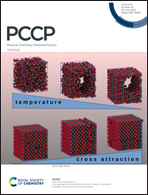Pyroglutamate-modified amyloid β(3–42) monomer has more β-sheet content than the amyloid β(1–42) monomer†
Abstract
The aggregation of the amyloid β (Aβ) peptide is a major hallmark of Alzheimer's disease. This peptide can aggregate into oligomers, proto-fibrils and mature fibrils, which eventually assemble into amyloid plaques in vivo. Several post-translational modifications lead to the presence of different forms of the Aβ peptide in the amyloid plaques with different biophysical and biochemical properties. While the canonical forms Aβ(1–40) and Aβ(1–42) have been found to be the major components of amyloid plaques, N-terminally pyroglutamate-modified variants, specifically pE-Aβ(3–42), amount to a significant fraction of the total Aβ plaque content of AD brains. With increased hydrophobicity, these variants display a more pronounced aggregation behaviour in vitro which, together with their higher stability against degradation in vivo is thought to make them crucial molecular players in the aetiology of AD. The peptide monomers are the smallest assembly units, and play an important role in most of the individual molecular processes involved in amyloid fibril formation, such as primary and secondary nucleation and elongation. Understanding the monomeric conformational ensembles of the isoforms is important in unraveling observed differences in their bio-physico-chemical properties. Here we use enhanced and extensive molecular dynamics simulations to study the structural flexibility of the N-terminally truncated Pyroglutamate modified isomer of Aβ, pE-Aβ(3–42) monomer, and compared it with simulations of the Aβ(1–42) peptide monomer under the same conditions. We find significant differences, especially in the secondary structure and hydrophobic exposure, which might be responsible for their different behaviour in biophysical experiments.



 Please wait while we load your content...
Please wait while we load your content...